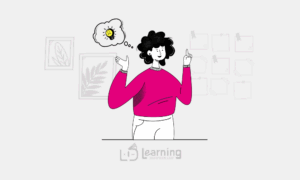Ever heard someone say, “Visual design is just fluff. What matters is the content”? Well, research tells a different story. We often see design vs. effectiveness as a false dichotomy, as if you have to choose between making something look good and making it work well. But great learning products don’t force that trade-off. Good design makes content effective. Let’s see some science-backed reasons why visuals matter in learning (and bust a few myths along the way).
1. Cognitive Load
We only have so much mental bandwidth. Cognitive Load Theory (Sweller, 1988) explains that when visuals and layouts are cluttered, inconsistent, or overwhelming, they create cognitive overload, making it harder to focus and retain information.
- KISS: Keep It Simple, Sweetheart
- Guide focus with highlights, contrast and spacing
- Reveal information gradually - avoid info dumps
🚫 Myth: More visuals equals better understanding.
✅ Truth: Too many or poorly designed visuals create mental load, not clarity.
2. The Right Mix
We process words and visuals separately but together, which is why well-balanced combinations enhance retention (Dual-Coding Theory, Paivio, 1971). The Multimedia Learning Theory (Mayer, 2001) provides some principles to optimize learning.
- Use images to reinforce key points
- Place visuals near related text
- Use visuals and narration instead of text and narration
🚫 Myth: Some people are visual learners.
✅ Truth: Learning styles are debunked. We all benefit from clear, structured content.
3. Human Perception
According to the Gestalt Principles (Wertheimer, 1923), our brains naturally group and prioritize visual information, which is why structured design makes content easier to process.
- Group elements to make connections clearer
- Make key content stand out from the background
- Guide the eye with cues
🚫 Myth: People will figure it out.
✅ Truth: Unintuitive design slows down learning.
4. First Impression Matters
Don Norman (Emotional Design, 2004) identifies three levels of emotional experience: visceral, behavioral, and reflective. The visceral level drives our instinctive, immediate reactions: how a product looks and feels at first glance. That’s why your learning experience should visually align with your brand.
- Use consistent imagery and fonts
- Use color and spacing to create ease
- Ensure clear layout and smooth navigation
🚫 Myth: Design doesn’t affect usability.
✅ Truth: People perceive beautiful designs as easier to use. But attention, bad usability breaks that illusion fast (Aesthetic-Usability Effect, Kurosu & Kashimura, 1995).
5. Make It Accessible
If your course is difficult to read, navigate, or understand, you might not reach everyone. The Web Content Accessibility Guidelines (WCAG) provide international standards for making digital content more accessible. Following these ensures a better experience for everyone, not just those with disabilities.
- Ensure enough contrast between text and background
- Use clear, readable fonts
- Structure content with proper headings and spacing
🚫 Myth: Accessibility is just for people with disabilities.
✅ Truth: Everyone benefits from a good layout.
Struggling with visual design in your learning content? If you want to make your courses more engaging, effective, and accessible, get in touch! I’d love to help you apply these principles to your materials.




